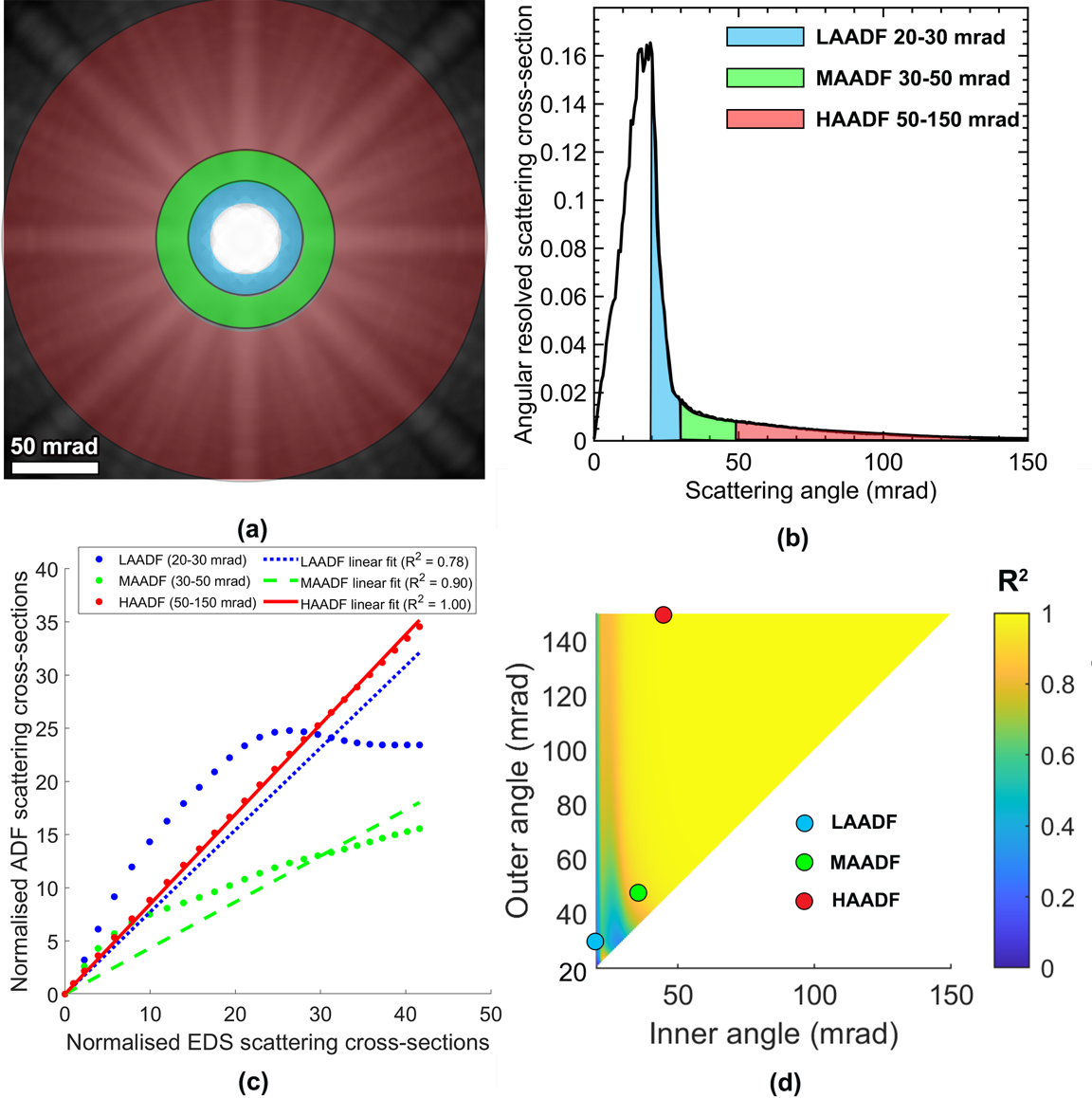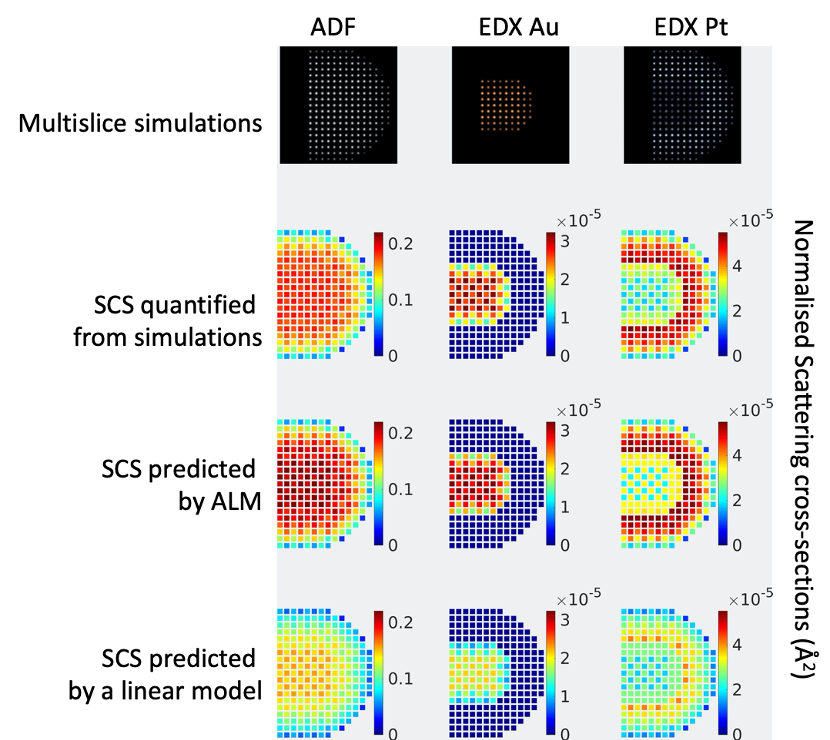Fast generation of calculated ADF-EDX scattering cross-sections under channelling conditions
- Abstract number
- 113
- Presentation Form
- Submitted Talk
- DOI
- 10.22443/rms.mmc2021.113
- Corresponding Email
- [email protected]
- Session
- Stream 1: EMAG - Spectroscopy & Advanced SEM
- Authors
- Dr. Zezhong Zhang (2, 3, 1), Dr. Annick De Backer (2, 3), Dr. Ivan Lobato (2, 3), Prof. Sandra Van Aert (2, 3), Prof. Peter Nellist (1)
- Affiliations
-
1. Department of Materials, University of Oxford
2. EMAT, University of Antwerp
3. NANOlab Center of Excellence, University of Antwerp
- Keywords
STEM, EDX, scattering cross-section, elemental quantification, multislice simulation
- Abstract text
To make the structure-property relationship in nanostructured materials, we need to probe their crystal structures and compositions at the atomic scale. From annular dark field scanning transmission electron microscopy (ADF-STEM), it has been demonstrated that one can determine the atomic column positions and count the number of atoms for homogenous materials with high precision and accuracy [1-2]. Advanced materials usually consist of multiple elements in a complicated structure and significant difficulties remain to disentangle the contributions of composition and thickness in STEM. Energy dispersive X-ray (EDX) spectroscopy and electron energy loss spectroscopy (EELS) can fingerprint different elements. With modern instrumentation, the acquisition of such spectrum imaging datasets at atomic resolution is now becoming increasingly routine. However, elemental quantification remains challenging due to dynamic scattering in combination with the enormous amount of possible mixed column configurations for a given composition. Here we propose to address these challenges by developing a method for the fast prediction of ADF-EDX signals under channelling conditions.
ADF and EDX have a non-linear relationship against thickness and composition due to dynamic electron scattering, particularly at the atomic scale in zone-axis orientation. However, preliminary experiments indicate a linear dependence between EDX and ADF scattering cross-sections, which is defined as the integration of signal intensities for each atomic column. As shown in Fig. 1, we performed multislice frozen phonon calculations for ADF and EDX simultaneously for a pure Au crystal and confirm such linearity of EDX against ADF with a high inner collection angle, which is a result of the incoherent nature of both signal modes.
Because of the incoherent signal mode, we can treat dynamical scattering as a superposition of individual atoms focussing the incident electrons. Here we expanded the so-called atomic lensing model [3] (developed previously for ADF) to spectroscopy. For a mixed column, the ordering possibilities of atoms in a mixed column grow exponentially with the thickness and types of elements thus quickly exceeding the capability of multislice calculations due to heavy computational costs. In contrast, the atomic lensing model allows fast generation of EDX scattering cross-sections with the ordering of elements taken into account under the channelling condition. As shown in Fig. 2 for a core-shell Au-Pt nanorod, scattering cross-sections extracted from the multislice calculations agree reasonably well with the atomic lensing model predictions but are very different from those of the linear model where the signal is assumed to scale linearly with the number of atoms for each type. To deploy the atomic lensing model to experimental results, we can incorporate the experimentally measured EDX partial cross-section [4], which is called partial since it includes all the microscope-dependent factors during normalisation thus bypassing the difficult characterisation of the EDX detector. This method allows us to explore the enormous ordering possibilities of heterogeneous materials with multiple elements.
Fig.1 Scattering cross-sections of ADF (with different collection angles) against EDX with linear regression, where the coefficient of determination R2 of EDX-ADF is a measure of linear dependence between different signal modes. The simulations were performed for an Au crystal in [001] direction with varying thicknesses (1-25 atoms), illuminated using 300 keV electrons with a 20 mrad condenser aperture and no lens aberrations.
Fig.2 Comparing the simulated and predicted scattering cross-sections (SCS) of ADF and EDX for an Au-Pt core-shell nanorod.
- References
[1] J.M. LeBeau, S.D. Findlay, L.J. Allen, S. Stemmer, Nano Letters 10 (2010) p. 4405–4408.
[2] A. De Backer, K.H.W. van den Bos, W. Van den Broek, J. Sijbers, and S. Van Aert, Ultramicroscopy 171 (2016) p. 104-116.
[3] K.H.W. van den Bos, A. De Backer, G.T. Martinez, N. Winckelmans, S. Bals, P.D. Nellist, S. Van Aert, Physical Review Letters 116 (2016) p. 246101.
[4] A. Varambhia, L. Jones, A. London, D. Ozkaya, P.D. Nellist, & S. Lozano-Perez, Micron 113 (2018) p. 69-82.
[5] The authors acknowledge financial support from the Research Foundation Flanders (FWO, Belgium) through Project No. G.0502.18N and a post-doctoral grant to ADB. This project has received funding from the European Research Council (ERC) under the European Union’s Horizon 2020 research and innovation programme (Grant Agreement No. 770887 PICOMETRICS and No. 823717 ESTEEM3).


